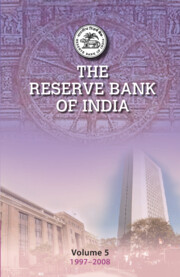Book contents
- Frontmatter
- Contents
- Tables
- Boxes
- Foreword
- Preface
- Acknowledgements
- List of Abbreviations
- 1 Introduction: Managing Liberalisation
- 2 The Macroeconomic Context
- 3 Monetary Management
- 4 Foreign Exchange Market and Management of the Capital Account
- 5 Foreign Exchange Reserves Management
- 6 Financial Markets
- 7 Public Debt Management
- 8 The Payment and Settlement Systems
- 9 Currency Management
- 10 Regulation of the Financial System – Part I: Commercial Banks
- 10 Regulation of the Financial System Part II: Other Financial Institutions
- 11 Supervision of the Financial System
- 12 Rural Credit
- 13 Financial Inclusion
- 14 Communication Policy
- 15 Organisational Change
- Appendices
- Photographs
- Select Bibliography
- Index
5 - Foreign Exchange Reserves Management
Published online by Cambridge University Press: 10 January 2023
- Frontmatter
- Contents
- Tables
- Boxes
- Foreword
- Preface
- Acknowledgements
- List of Abbreviations
- 1 Introduction: Managing Liberalisation
- 2 The Macroeconomic Context
- 3 Monetary Management
- 4 Foreign Exchange Market and Management of the Capital Account
- 5 Foreign Exchange Reserves Management
- 6 Financial Markets
- 7 Public Debt Management
- 8 The Payment and Settlement Systems
- 9 Currency Management
- 10 Regulation of the Financial System – Part I: Commercial Banks
- 10 Regulation of the Financial System Part II: Other Financial Institutions
- 11 Supervision of the Financial System
- 12 Rural Credit
- 13 Financial Inclusion
- 14 Communication Policy
- 15 Organisational Change
- Appendices
- Photographs
- Select Bibliography
- Index
Summary
Introduction
Chapter 4 discussed key developments in the external sector and changes in the regulatory regime. This chapter will concentrate on the management of the exchange rate and foreign exchange reserves. During the years of interest, in the wake of cross-border capital flows of unprecedented scale, the Reserve Bank needed to intervene deeply in the foreign exchange, or forex, market to stabilise the rupee and to devise measures to prevent currency speculation. While the Bank’s stance on exchange rate was sometimes criticised, it succeeded in this aim, as this chapter will show. The chapter has four sections: The first two will deal with the exchange rate, presenting a chronological account of market intervention, and a discussion of some of the major debates and policy issues. The third section will deal with the management of reserves, and the fourth with policy on gold and its import, and related matters.
Exchange Rate Management: A Chronological Account
The Reserve Bank derives its authority to manage the exchange rate of the rupee from the Reserve Bank of India (RBI) Act, 1934. The word ‘stability’ in the phrase ‘with a view to securing monetary stability … and generally to operate the currency and credit system of the country to its advantage’, appearing in the preamble, can mean internal as well as external stability. External stability, in turn, should mean maintaining a stable exchange rate. Section 40 of the Act, however, states that ‘the Central Government may, by order, determine foreign exchange at such rates of exchange and on such conditions as the Central Government may from time to time … determine’. These extracts suggest that exchange rate management is in the domain of the government, which delegated this power to the Reserve Bank. As we shall see, these clauses made the process of reforming exchange rate management a particularly interactive one.
Cross-border capital flows became more volatile from 1997 to 2008 because of both external and domestic developments, as we have seen (Chapters 3 and 4). Exchange rate management during this period became more challenging as a result. These eleven years can be divided into two parts. Between April 1997 and March 2003, the rupee (nominal) depreciated by nearly 25 per cent.
- Type
- Chapter
- Information
- The Reserve Bank of IndiaVolume 5, 1997–2008, pp. 147 - 186Publisher: Cambridge University PressPrint publication year: 2023



